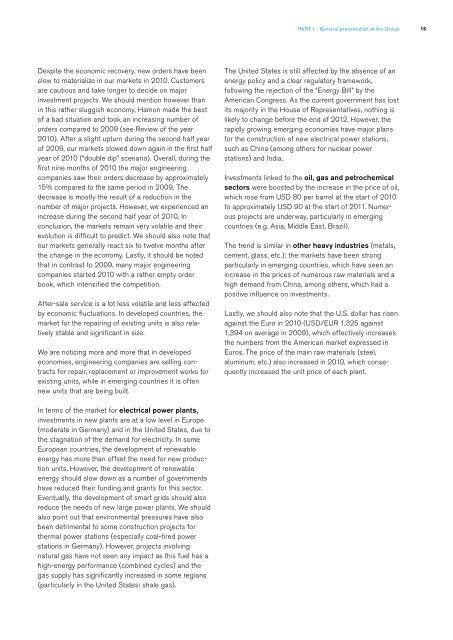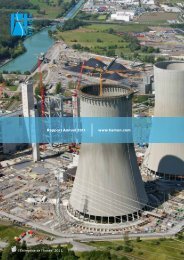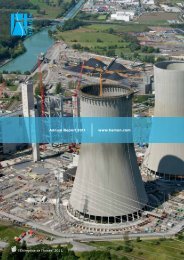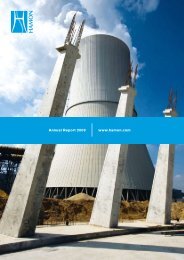Download PDF version English(2664KB) - Hamon
Download PDF version English(2664KB) - Hamon
Download PDF version English(2664KB) - Hamon
You also want an ePaper? Increase the reach of your titles
YUMPU automatically turns print PDFs into web optimized ePapers that Google loves.
Part 1 - General presentation of the Group<br />
15<br />
Despite the economic recovery, new orders have been<br />
slow to materialize in our markets in 2010. Customers<br />
are cautious and take longer to decide on major<br />
investment projects. We should mention however than<br />
in this rather sluggish economy, <strong>Hamon</strong> made the best<br />
of a bad situation and took an increasing number of<br />
orders compared to 2009 (see Review of the year<br />
2010). After a slight upturn during the second half year<br />
of 2009, our markets slowed down again in the first half<br />
year of 2010 (“double dip” scenario). Overall, during the<br />
first nine months of 2010 the major engineering<br />
companies saw their orders decrease by approximately<br />
15% compared to the same period in 2009. The<br />
decrease is mostly the result of a reduction in the<br />
number of major projects. However, we experienced an<br />
increase during the second half year of 2010. In<br />
conclusion, the markets remain very volatile and their<br />
evolution is difficult to predict. We should also note that<br />
our markets generally react six to twelve months after<br />
the change in the economy. Lastly, it should be noted<br />
that in contrast to 2009, many major engineering<br />
companies started 2010 with a rather empty order<br />
book, which intensified the competition.<br />
After-sale service is a lot less volatile and less affected<br />
by economic fluctuations. In developed countries, the<br />
market for the repairing of existing units is also relatively<br />
stable and significant in size.<br />
We are noticing more and more that in developed<br />
economies, engineering companies are selling contracts<br />
for repair, replacement or improvement works for<br />
existing units, while in emerging countries it is often<br />
new units that are being built.<br />
The United States is still affected by the absence of an<br />
energy policy and a clear regulatory framework,<br />
following the rejection of the “Energy Bill” by the<br />
American Congress. As the current government has lost<br />
its majority in the House of Representatives, nothing is<br />
likely to change before the end of 2012. However, the<br />
rapidly growing emerging economies have major plans<br />
for the construction of new electrical power stations,<br />
such as China (among others for nuclear power<br />
stations) and India.<br />
Investments linked to the oil, gas and petrochemical<br />
sectors were boosted by the increase in the price of oil,<br />
which rose from USD 80 per barrel at the start of 2010<br />
to approximately USD 90 at the start of 2011. Numerous<br />
projects are underway, particularly in emerging<br />
countries (e.g. Asia, Middle East, Brazil).<br />
The trend is similar in other heavy industries (metals,<br />
cement, glass, etc.); the markets have been strong<br />
particularly in emerging countries, which have seen an<br />
increase in the prices of numerous raw materials and a<br />
high demand from China, among others, which had a<br />
positive influence on investments.<br />
Lastly, we should also note that the U.S. dollar has risen<br />
against the Euro in 2010 (USD/EUR 1,325 against<br />
1,394 on average in 2009), which effectively increases<br />
the numbers from the American market expressed in<br />
Euros. The price of the main raw materials (steel,<br />
aluminum, etc.) also increased in 2010, which consequently<br />
increased the unit price of each plant.<br />
In terms of the market for electrical power plants,<br />
investments in new plants are at a low level in Europe<br />
(moderate in Germany) and in the United States, due to<br />
the stagnation of the demand for electricity. In some<br />
European countries, the development of renewable<br />
energy has more than offset the need for new production<br />
units. However, the development of renewable<br />
energy should slow down as a number of governments<br />
have reduced their funding and grants for this sector.<br />
Eventually, the development of smart grids should also<br />
reduce the needs of new large power plants. We should<br />
also point out that environmental pressures have also<br />
been detrimental to some construction projects for<br />
thermal power stations (especially coal-fired power<br />
stations in Germany). However, projects involving<br />
natural gas have not seen any impact as this fuel has a<br />
high-energy performance (combined cycles) and the<br />
gas supply has significantly increased in some regions<br />
(particularly in the United States: shale gas).














